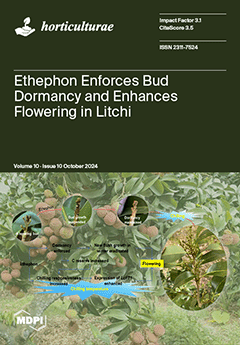Drought is a major stress that hinders plant growth and causes water stress, posing a significant threat to global food security. While nanotechnology, particularly the use of nanoparticles such as TiO
2, offers a promising solution by enhancing plants’ resilience to drought
[...] Read more.
Drought is a major stress that hinders plant growth and causes water stress, posing a significant threat to global food security. While nanotechnology, particularly the use of nanoparticles such as TiO
2, offers a promising solution by enhancing plants’ resilience to drought stress, improving nutrient absorption, and promoting growth under adverse conditions, its application in viticulture remains underexplored. The objective of this research was to investigate the effects of titanium dioxide nanoparticles (TiO
2-NPs; 100, 10, 1, and 0 ppm (control)) on various physiological, biochemical, and morphological parameters in grapevine saplings. Three different rootstock varieties, 41 B/Crimson Seedless (CS), 1103 P/CS, and 5 BB/CS, were included in the experiment to assess how rootstock variety influences the response of grapevine saplings to TiO
2-NPs under drought stress (40–50%) and well-irrigated (90–100%) conditions. Young vines grown in pots under greenhouse conditions were used in this study. Applications of 10 ppm TiO
2-NPs improved growth parameters and the SPAD index and enhanced stomatal conductance, relative water content, and protein content in grapevine saplings under both drought and well-irrigated conditions. Conversely, oxidative stress parameters, including the membrane damage index, hydrogen peroxide, drought index, and lipid peroxidation levels, were significantly reduced following 10 ppm TiO
2-NP applications under drought conditions. Furthermore, total phenolic content, proline content, and ascorbate peroxidase, catalase, and superoxide dismutase activities, which increased significantly with drought stress, were reduced to lower levels, paralleling the alleviation of drought-induced oxidative stress. Our results suggest that the primary role of TiO
2 nanoparticles in enhancing drought tolerance is due to their beneficial effects in alleviating damage caused by drought stress. This finding applies not only to grapevines but may also be relevant for other agricultural crops.
Full article





